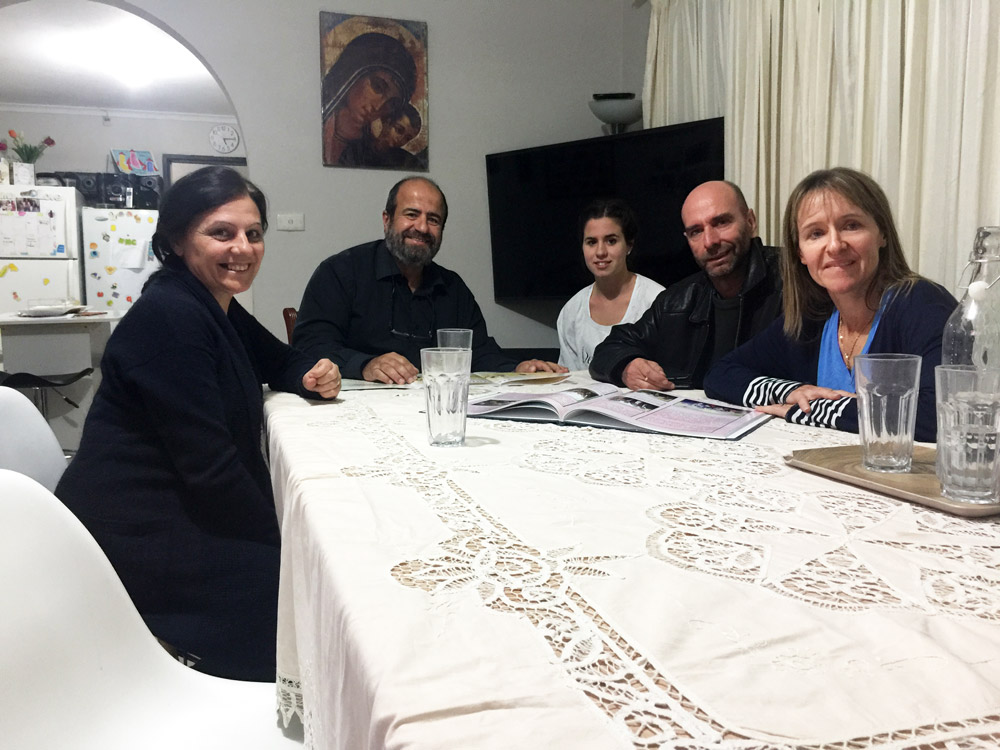Four generations join 150,000 pilgrims in 10-day pilgrimage to Rome

Discussing their trip from left is Tania, Gerald and Gabrielle Scerri, and Paul and Christina Hill. Picture: Fiona van der Plaat.
By FIONA VAN DER PLAAT.
GERALD Scerri was initially reluctant to join the 10-day pilgrimage to Rome in early May to mark the 50th anniversary of the Neocatechumenal Way.
He and his wife, Tania, were “too busy concentrating on the reality here” in Canberra, including their 10 children and 14 grandchildren, to focus on the bigger picture.
In the end he chose to join the 16 pilgrims from Canberra, along with his wife and youngest daughter Gabrielle, 17, and was glad he did.
“It wasn’t until I got there that I realised how important it was for me to go,” Mr Scerri said.
Seeing the four generations of followers among the 150,000 pilgrims was enough to remind him of his important place in a “beautiful tapestry in which everyone is connected”.
His decision to go was also consistent with Pope Francis’ message during his address to the pilgrims at Tor Vergata in Rome.
“Go. The mission demands that we leave,” he said.
“But, in life, there is a strong temptation to remain, not to take risks … It is easier to stay at home, surrounded by those who love us, but it is not Jesus’ way.”
It was this mission that prompted Paul and Christina Hill to pack up four (aged 9, 11, 13 and 18) of their eight children and join the Canberra pilgrims.
“It wasn’t easy,” Mrs Hill said of the arrangements needed to make it all happen.
“It was a lot of work to leave the others in Canberra.”
But support from their family and local community, along with hospitality from the Way’s community during the pilgrimage, enabled them to join a gathering that reminded them of their part in something much bigger than themselves.
“The reality is [the community] is quite small in Canberra and you can feel quite isolated and even persecuted,” Mrs Hill said.
Her overwhelming reaction to celebrating with the wider community was “joy and a huge sense of gratefulness to God”.
For Mr Hill, who admitted it was not easy to be a Catholic in today’s society, the pilgrimage offered a chance to evangelise, as directed by the Pope, regardless of how “scary” that could be.
Gabrielle Scerri, meanwhile, relished the chance to celebrate with people who shared her faith and commitment.
“It was harder coming back here because it is harder to be Christian here – it’s a cultural thing, I think,” she said.
While Mr Scerri described the pilgrimage as “very relaxed”, Mrs Scerri stressed it was “not just a holiday and tour of Rome, but a formation for all of us”.
“We were all connected. We were all there because the word of God brought us there,” she said.
On the Way:
The Neo-catechumenal Way was defined by Pope John Paul II as “an itinerary of Catholic formation, valid for our society and for our times”.
It was formed in Spain in 1964 and communities were first established in Rome in 1968.
The Way was introduced to Australia in 1977 and now has communities in four parishes in Canberra.


